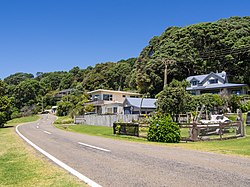|
Ōhiwa
Ōhiwa is a rural settlement in the Ōpōtiki District and Bay of Plenty Region of New Zealand's North Island. It is on a headland on the eastern side of Ōhiwa Harbour, and on the western side of the Waiotahe River mouth.[3] The New Zealand Geographic Board officially included the macron in the name from 16 July 2020.[4] The Ferry Hotel was opened at Ōhiwa in 1873, together with a ferry service to Ōhope. A post office opened in the growing town in 1877. Unstable sand and erosion from 1915 destroyed the town. A second attempt to create sections for baches in the 1960s was also lost to erosion in 1978.[5] Onekawa Te Mawhai Regional Park was created on the headland in 2010. It incorporates areas of archaeological importance from long Māori use of the area, including Onekawa pā.[6] A local campground provides accommodation.[7] DemographicsŌhiwa is described by Statistics New Zealand as a rural settlement, which covers 3.96 km2 (1.53 sq mi)[1] and had an estimated population of 180 as of June 2024,[2] with a population density of 45 people per km2. It is part of the wider Waiotahi statistical area.[8]
Ōhiwa had a population of 171 at the 2018 New Zealand census, an increase of 15 people (9.6%) since the 2013 census, and a decrease of 6 people (−3.4%) since the 2006 census. There were 69 households, comprising 84 males and 93 females, giving a sex ratio of 0.9 males per female. The median age was 55.6 years (compared with 37.4 years nationally), with 27 people (15.8%) aged under 15 years, 15 (8.8%) aged 15 to 29, 87 (50.9%) aged 30 to 64, and 48 (28.1%) aged 65 or older. Ethnicities were 89.5% European/Pākehā, 24.6% Māori, and 1.8% Asian. People may identify with more than one ethnicity. Although some people chose not to answer the census's question about religious affiliation, 61.4% had no religion, 28.1% were Christian, 7.0% had Māori religious beliefs, 1.8% were Hindu and 3.5% had other religions. Of those at least 15 years old, 42 (29.2%) people had a bachelor's or higher degree, and 15 (10.4%) people had no formal qualifications. The median income was $32,900, compared with $31,800 nationally. 27 people (18.8%) earned over $70,000 compared to 17.2% nationally. The employment status of those at least 15 was that 69 (47.9%) people were employed full-time, 18 (12.5%) were part-time, and 6 (4.2%) were unemployed.[9] References
|
|||||||||||||||||||||||||||||||||||||||||||||||||||||

